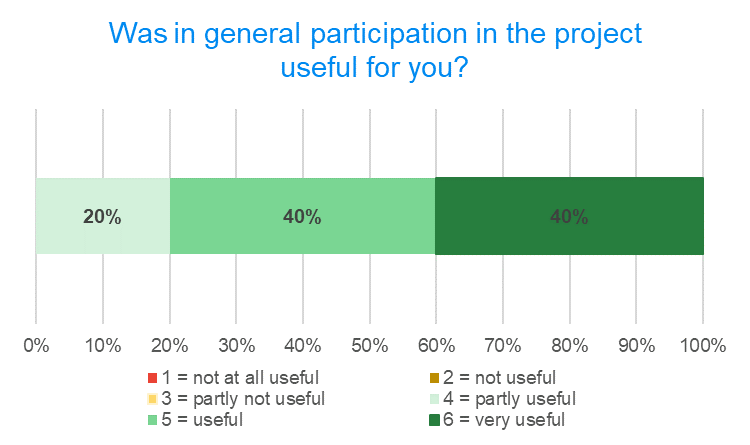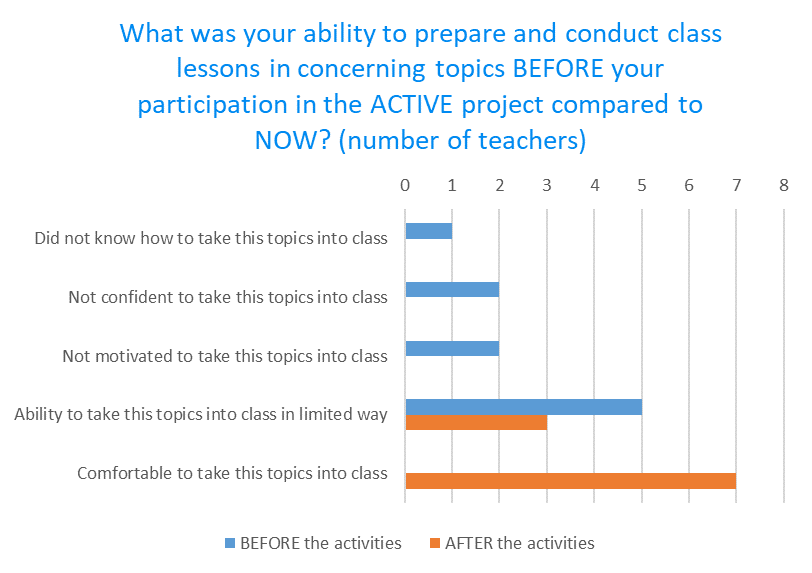The ACTIVE Toolkit was directly implemented by 13 teachers during the school year 2022/2023 in 5 countries Austria, Italy, Poland, Slovakia and Czech Republic. Altogether 735 students was involved in 27 class activities.
The activities were done by teachers during regular school classes mainly in language classes (Italian, English), geography and history and human/citizenship studies.

How the implementation of the ACTIVE Toolkit was assessed by the teachers?
All the teachers found their participation in the project as useful. Very useful was the participation for 40% of the teachers and for 20% partly useful. The teachers for which the participation in the project was only partly useful were those who rated their skills in concerned topics as very high even before the participation in project participation.

Source: Ex-post evaluation of the implementation of the ACTIVE Toolkit in classes (based on questionnaire to teachers who implemented the ACTIVE Toolkit in schools)
Based on the outcomes of self assessment the teachers have thanks to the project improved their skills in respective areas (in average from 5,5 to 7,5 on the scale from 1 to 9). The participation helped teachers to improve their skills in following areas:
- understanding general principles concerning data and information,
- understanding Fake-news & disinformation,
- understanding use of sources from internet,
- to deal with different opinions,
- to design research activity,
- to design lesson for class in related topics,
- to conduct a lesson in related topics.

Source: Ex-post evaluation of the implementation of the ACTIVE Toolkit in classes (based on questionnaire to teachers who implemented the ACTIVE Toolkit in schools)
Note: rated on scale 1 to 9 where 1 corresponds to limited knowledge and 9 corresponds to proficient knowledge
The involvement of the teachers in the project activities and implementation of the ACTIVE Toolkit in the classes had significant positive impact in their ability to bring the concerned topics of fake-news, disinformation and controversial topics into the class activities.

Source: Ex-post evaluation of the implementation of the ACTIVE Toolkit in classes (based on questionnaire to teachers who implemented the ACTIVE Toolkit in schools)
What the teachers have gained from the implementing of the ACTIVE Toolkit in the class with students by their own words:
- I have learnt how to make students more aware of fake news and disinformation. I also got to know how to design research activity.
- How to identify biases
- New examples and inspiration for my own lessons. I was forced to create new activities, study more sources. And also an experience by participation in international erasmus project.
- How to conduct lesson, design research activity, design lesson for class.
- I got a lot of different ideas of how to implement the critical view on information and sources into a lesson.
- I have learned not to deliver related activities with preconceived ideas or expected outcomes. The students often surprised with their observations and opinions and it was often difficult to dismiss these in favour of more orthodox beliefs. I also learned that students were often far more information source literate than the teacher and were far more able to recognise examples of disinformation, misinformation and fake news.
- I learned to sort information better to prepare activities for students. I myself learned better to understand the individual steps when working with fake news. I have a better overview of activities that are focused on topics, which are related to fake news and work with information sources.
- A new inspirations for my lessons, another points of view (education across participate countries)
- Considering how the mind works and is subject to prejudices, biases and “confort zones” and how they could deceive our reasoning capability and be misleading.
Continuation of the usage of the Toolkit by teachers
All the involved teachers are continuing in conducting activities considering the ACTIVE Toolkit in the school year following the participation in the project. This shows and proves the attractiveness of the topics and approaches of the ACTIVE methodology.
Conclusions
We are happy that based on the ex-post evaluation assessment outcomes the ACTIVE approach and the ACTIVE Toolkit was proven as beneficial for the teachers. The ACTIVE approach is designed to help teachers to bring controversial topics and disinformation into the class. Now the ACTIVE Toolkit is offered to broad range of schools and teachers. If you have any interest you can also contact us directly.
